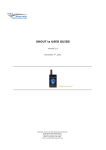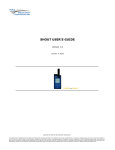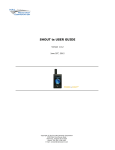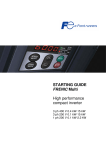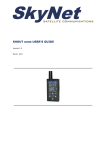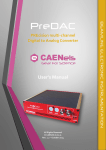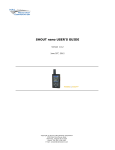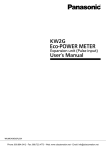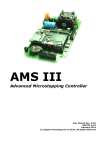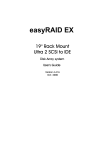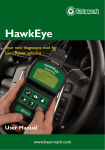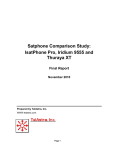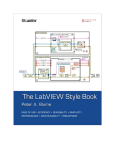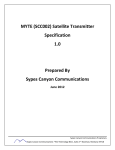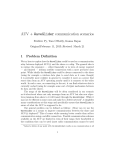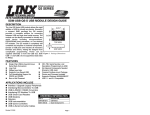Download STM3 User Manual
Transcript
STM3 User Manual Document Number: CMDC-DOC-1767 Document Revision: 1.14 Date: September 30, 2010 © Comtech Mobile Datacom Corporation (Comtech). All Rights Reserved This document contains information which is privileged, confidential, and/or proprietary to Comtech. This information is commercially sensitive in nature, is not made generally available for public review. The information contained herein is protected, among other things by the Trade Secrets Act, as codified, and any improper use, distribution, or reproduction is specifically prohibited. Comtech makes no representations or warranties, either express or implied, as to the information’s adequacy, sufficiency, or freedom from defect of any kind, including freedom from any patent infringement that may result from the use of such information, nor shall Comtech incur any liability or obligation whatsoever by reason of such information. Comtech’s disclosure of this information shall in no manner grant to the receiving party any right, title, interest, or license in or to the information, other than its use in accordance with the purposes specifically set forth in writing between Comtech and the receiving party. Under no condition should the information contained herein be provided in any manner whatsoever to any third party without the prior express written permission of Comtech, and the concurrent execution of a suitable Non-Disclosure Agreement. CMDC Confidential and Proprietary Information - Use and Disclosure Restrictions Apply Page 1 of 38 Comtech Mobile Datacom Corporation CMDC-DOC-1767, Rev. 1.14 Revision History Revision Revision Date 1.1 03/03/2010 Description of the Changes New Document 1.2 Review of content to see progress. 1.3 Continued putting content into document 1.4 03/18/2010 Put in comments from Garrett & Saad review. Including Global changes: • Chopin -> STM3 • Chopin Module -> Chopin device • Unit ID -> ESN • STU -> STM3 • Should/shall – present tense (and will when applicable) • High / low power to standard power • “_” to identify pin names that may not be capitalized. Replaced with all caps where found Reformatted all table headings to center alignment (vertically/horizontally) Replaced pinout illustration with revised and reviewed drawing Highlighted all TBDs and put in notes identifying content to re-review 1.5 Kerry Keksz Accepted edits and text changes. Touched up Figure 7 Timing diagram. Responded to comment questions. Added content on ACK and NAK. Minor edits made to new paragraph with Track Changes on. 1.6 Kerry Keksz Put in Operating and Storage temperatures. Global search/replace to replace to STM3, replace air interface with OTA, replace TTL with 3.3V CMOS, and consistent use of Celsius and µ font. Updated RF Timing Spectrum. Content edits throughout per SME review. CMDC Confidential and Proprietary Information - Use and Disclosure Restrictions Apply Page 2 of 38 Comtech Mobile Datacom Corporation 1.7 Saad Anis 1.8 Chris Thorne 1.9 Garrett Chandler 1.10 CMDC-DOC-1767, Rev. 1.14 Accepted all comments and made minor changes throughout. Removed current consumptions on V_RF1 And V_RF2 until measurements are verified. Added details of SPI interface. Corrected CTS_RDY and RTS_CE pin names. Corrected table and figure cross-references. Anthony Valenzano Updated power levels. Updated firmware version. Changed tries to 5. Changed antenna gain to 5dBi. Added recommended antenna. Added recommendations for external antennas. Corrected current consumption. Total current consumption should be the digital consumption current plus the RF power consumption. 1.11 Garrett Chandler 1.12 Saad Anis 1.13 Garrett Chandler Updated firmware version number. Added Certification Section Information. Clean up formatting of document and content. Moved notice of certification requirements to Notices section of document. 1.14 Saad Anis Added FCC/IC Notes and reformatted Globalstar Notes. CMDC Confidential and Proprietary Information - Use and Disclosure Restrictions Apply Page 3 of 38 Comtech Mobile Datacom Corporation CMDC-DOC-1767, Rev. 1.14 Notices The following terms are used in specific context throughout this document: WARNINGS, CAUTIONS, NOTES, and TIPS. WARNINGS are for procedures that, if not followed, may result in personal injury or death. CAUTIONS are for procedures that, if not followed, may result in hardware or software damage or failure. NOTES are included to provide the operator with additional information intended to simplify a step or entire procedure. TIPS are included for the operator detailing useful information about using the equipment and software. FCC/ IC NOTES: The STM3 is a transmitter module designed for mobile or fixed operations. STM3 devices will be manufactured with labels that include product information including FCC ID and IC ID of UQR-CMDCSTM3 and 8863A-CMDCSTM3 respectively. Purchasers of the STM3 devices are required to do one of the following while integrating the STM3 module into their products: Provide visibility of the STM3 module through a window or, Provide an easy way to get to the module when an access panel or door is removed or, Place a label on the outside of the final (integrator) product that contains the following texts: “Contains FCC ID: UQR-CMDCSTM3” and “Contains IC: 8863A-CMDCSTM3”. GLOBALSTAR NOTE: CMDC Confidential and Proprietary Information - Use and Disclosure Restrictions Apply Page 4 of 38 Comtech Mobile Datacom Corporation CMDC-DOC-1767, Rev. 1.14 Purchasers or integrators of the STM3 are required to have the products that incorporate the STM3 module certified by Globalstar before they can be activated, tested, or otherwise used on the Globalstar satellite constellation. Integrators are fully responsible for all regulatory and business licensing requirements wherever the products are sold or used. Once a product is approved, the integrator will need to provide Globalstar with regularly updated lists of STM3 ESNs in these products so that end customers will be able to activate and use the products. Integrators are highly encouraged to work with Globalstar through Comtech, preferably beginning in the product design stage to understand the system specifications and requirements, design in the correct features, plan for regulatory approvals, and plan for transmission of manufacturing information as their products are produced. Comtech’s point of contact for any Globalstar certification is: SENS Product Realization Manager [email protected] Voice: 1866-631-6010 CAUTION: RF exposure hazard. This unit must be operated with a minimum separation distance of 20 cm from a person’s body. CMDC Confidential and Proprietary Information - Use and Disclosure Restrictions Apply Page 5 of 38 Comtech Mobile Datacom Corporation CMDC-DOC-1767, Rev. 1.14 Table of Contents 1. ABOUT THIS MANUAL ....................................................................................... 9 1.1. 1.2. 1.3. 1.4. 1.5. 1.6. 2. INTRODUCTION TO THE STM3..................................................................... 12 2.1. 2.2. 2.3. 2.4. 2.5. 2.6. 3. PURPOSE OF THIS SECTION ................................................................................... 15 RF FREQUENCY .................................................................................................... 15 RF POWER ............................................................................................................ 15 RF TIMING ........................................................................................................... 15 OUTPUT IMPEDANCE ............................................................................................ 16 RF ANTENNA ....................................................................................................... 16 RF ANTENNA FEED .............................................................................................. 17 USER INTERFACE ............................................................................................. 18 4.1. 4.2. 4.3. 4.4. 4.5. 4.6. 4.7. 4.8. 4.9. 4.10. 4.11. 5. PURPOSE OF THIS SECTION ................................................................................... 12 DESCRIPTION OF STM3 ........................................................................................ 12 HOW IT WORKS .................................................................................................... 13 BASIC ARCHITECTURE .......................................................................................... 13 TYPICAL INTEGRATION ......................................................................................... 14 OVER-THE-AIR INTERFACE .................................................................................. 14 RF SPECIFICATIONS ........................................................................................ 15 3.1. 3.2. 3.3. 3.4. 3.5. 3.6. 3.7. 4. PURPOSE OF THIS SECTION ..................................................................................... 9 INTENT OF THIS DOCUMENT ................................................................................... 9 CONVENTIONS ........................................................................................................ 9 DESCRIPTION OF DOCUMENT CONTENTS ................................................................ 9 FIRMWARE VERSION APPLICABILITY ..................................................................... 9 ACRONYMS .......................................................................................................... 11 PURPOSE OF THIS SECTION ................................................................................... 18 SERIAL COMMUNICATIONS ................................................................................... 18 SERIAL PACKET FORMAT ..................................................................................... 19 UART SERIAL PORT CONFIGURATION ................................................................. 21 UART SERIAL PORT TIMING ................................................................................ 21 SPI SERIAL PORT CONFIGURATION ...................................................................... 22 SPI PORT TIMING ................................................................................................. 22 OPEN COLLECTOR OUTPUT CHARACTERISTICS .................................................... 23 CRC COMPUTATION............................................................................................. 23 ANTENNA PORT .................................................................................................... 23 STM3 ELECTRONIC SERIAL NUMBER................................................................... 24 TEST INPUTS....................................................................................................... 25 5.1. PURPOSE OF THIS SECTION ................................................................................... 25 5.2. TEST1 AND TEST2 MODES ................................................................................. 25 CMDC Confidential and Proprietary Information - Use and Disclosure Restrictions Apply Page 6 of 38 Comtech Mobile Datacom Corporation 6. CMDC-DOC-1767, Rev. 1.14 CONFIGURABLE FEATURES.......................................................................... 26 6.1. PURPOSE OF THIS SECTION ................................................................................... 26 6.2. SYSTEM CONFIGURATION ..................................................................................... 26 7. INTERFACES AND CONNECTORS ................................................................ 27 7.1. PURPOSE OF THIS SECTION ................................................................................... 27 7.2. SURFACE MOUNT PAD DESIGNATIONS ................................................................. 27 8. MECHANICAL .................................................................................................... 30 8.1. 8.2. 8.3. 8.4. 9. PURPOSE OF THIS SECTION ................................................................................... 30 MECHANICAL SPECIFICATIONS ............................................................................. 30 RECOMMENDED PCB FOOTPRINT ......................................................................... 30 GENERAL STM3 MOUNTING GUIDELINES ............................................................ 31 POWER SUPPLY ................................................................................................. 32 9.1. PURPOSE OF THIS SECTION ................................................................................... 32 9.2. DC POWER MODES............................................................................................... 32 9.3. POWER SOURCE .................................................................................................... 33 10. ENVIRONMENTAL SPECIFICATIONS ......................................................... 34 10.1. PURPOSE OF THIS SECTION ................................................................................... 34 10.2. POWER SPECIFICATIONS ....................................................................................... 34 10.3. ENVIRONMENTAL AND MECHANICAL SPECIFICATIONS ........................................ 34 11. EMI / EMC COMPATIBILITY .......................................................................... 35 11.1. PURPOSE OF THIS SECTION ................................................................................... 35 11.2. COMPLIANCE STANDARDS .................................................................................... 35 APPENDIX A – CRC CALCULATION ALGORITHM........................................... 36 APPENDIX B – MECHANICAL DRAWINGS.......................................................... 37 CMDC Confidential and Proprietary Information - Use and Disclosure Restrictions Apply Page 7 of 38 Comtech Mobile Datacom Corporation CMDC-DOC-1767, Rev. 1.14 List of Figures Figure 1: System Overview .............................................................................................. 12 Figure 2: STM3 ................................................................................................................. 13 Figure 3: Multiple Packet Transmission Sequence........................................................... 14 Figure 4: RF Timing Spectrum ......................................................................................... 16 Figure 5: Packet Format .................................................................................................... 19 Figure 6: SPI Interface Timing Diagram .......................................................................... 23 Figure 7: STM3 Pinout Diagram ...................................................................................... 27 Figure 8: Recommended PCB Pad Landing ..................................................................... 31 Figure 9: Module Dimensions .......................................................................................... 37 Figure 10: Castellation Detail ........................................................................................... 38 Figure 11: Isometric View ................................................................................................ 38 List of Tables Table 1: Document Structure ............................................................................................ 10 Table 2: Channel and Frequency ...................................................................................... 15 Table 3: RF Trace Parameters........................................................................................... 17 Table 4: Serial Packet Commands and Responses ........................................................... 20 Table 5: ESN Structure ..................................................................................................... 24 Table 6: Test Modes.......................................................................................................... 25 Table 7: Non-Volatile Parameters .................................................................................... 26 Table 8: STM3 Pin Descriptions....................................................................................... 28 Table 9: Power Modes and Usage .................................................................................... 32 CMDC Confidential and Proprietary Information - Use and Disclosure Restrictions Apply Page 8 of 38 Comtech Mobile Datacom Corporation 1. ABOUT THIS MANUAL 1.1. Purpose of this Section CMDC-DOC-1767, Rev. 1.14 The purpose of this section is to introduce the user to the terminology and organization of this manual. 1.2. Intent of this Document This document is intended for integrators who are seeking a general overview of CMDC’s STM3 device and integration instructions. This document provides a general introduction and understanding of the following: • • • 1.3. STM3 functions and architecture STM3 integration and connectivity Understanding of the User Interface Conventions Typographical conventions used in this document are as follows: Commands User Input All interface commands are in Black Courier Font. Commands are case sensitive. All commands must be entered in lower case. All commands and parameters the user enters appear in Black Bold Courier font. Field Names STM3 field names appear in italics. <argument> All interface commands that have an optional or required argument are indicated by slanted brackets <argument>. CAPITAL LETTERS Used for emphasis, for example, DO NOT spray water on the module. 1.4. Description of Document Contents This document is organized into functional sections described in Table 1. Some sections of the document are targeted for integrators who know very little about the Comtech SENS network, other sections are for more experienced integrators who are interested in configuring the STM3 device. 1.5. Firmware Version Applicability The contents of this document describe the features and functionality of the STM3 firmware version 1.19. CMDC Confidential and Proprietary Information - Use and Disclosure Restrictions Apply Page 9 of 38 Comtech Mobile Datacom Corporation CMDC-DOC-1767, Rev. 1.14 Table 1: Document Structure Section # Description Section 1: About This Manual Provides an understanding of this manuals intent, organization, terminology and conventions used throughout this document. This section is useful to all readers of this document. Section 2: Introduction to Provides a description of the STM3 device, the system architecture, and how the STM3 device works. This section also provides typical integration, operating environment, and interface information. This section is useful for all integrators. Section 3: RF This section provides RF performance-related specifications for integrating the STM3 device into a device. This section is useful to all designers and integrators. Section 4: User Interface This section describes the user interface including connectivity and requirements, how it functions, and how to integrate and configure the STM3 device. This section is useful to all integrators. Section 5: Test Inputs This section describes test inputs and modes, along with their functionality. This section is useful to integrators and those testing the module after integration and configuration. Section 6: Configurable Features This section describes how to configure the STM3 device using commands. This section includes configurable features, commands, and their parameters. This section is useful to integrators and software developers. Section 7: Interfaces and Connectors This section describes STM3 device dimensions and requirements for integrating the STM3 device onto a printed circuit board. This section includes pin-outs. This section is useful to all integrators. Section 8: Mechanical This section provides mechanical specifications (drawings are included in Appendix B – Mechanical Drawings). This section is useful to all designers and integrators who are integrating the STM3 device onto a printed circuit board and into a device. Section 9: Power Supply This section describes power modes, how they function, and how an integrator can use them when integrating the STM3 device into the overall system. This section also provides power requirements and parameters and is useful to all integrators. Section 10: Environmental Specifications This section describes the STM3 device specifications and is useful to all integrators. Section 11: EMI / EMC Compatibility This section describes compliance specifications to which the STM3 device was designed to and lists the compliance testing conducted. CMDC Confidential and Proprietary Information - Use and Disclosure Restrictions Apply Page 10 of 38 Comtech Mobile Datacom Corporation 1.6. CMDC-DOC-1767, Rev. 1.14 Acronyms CMDC – Comtech Mobile Datacom Corporation CMOS – Complementary Metal–Oxide–Semiconductor CPLD – Complex Programmable Logic Device CRC – Cyclic Redundancy Check ESN – Electronic Serial Number FCC – Federal Communications Commission LDO – Low-Dropout LHCP – Left-Hand Circularly Polarized OC – Open Collector OTA – Over-the-Air PA – Power Amplifier PCB – Printed Circuit Board PLL – Phase Lock Loop RF – Radio Frequency RMS – Root Mean Squared SENS – Sensor Enabled Notification System SPI – Serial Peripheral Interface STM3 – SENS Transmitter Module 3 UART – Universal Asynchronous Receiver/Transmitter VSWR – Voltage Standing Wave Ratio CMDC Confidential and Proprietary Information - Use and Disclosure Restrictions Apply Page 11 of 38 Comtech Mobile Datacom Corporation 2. INTRODUCTION TO THE STM3 2.1. Purpose of this Section CMDC-DOC-1767, Rev. 1.14 The purpose of this section is to introduce the integrator to the STM3 device and how it works. This includes a system overview of the STM3 environment, a description of the STM3 device and how it works, its architecture, and a typical integration and operating environment as well as an understanding of the Over-the-Air (OTA) interface. 2.2. Description of STM3 The STM3 device provides simplex modem functionality that sends packet-switched data containing user information through a satellite constellation to ground stations and then to the end user via the Internet (see Figure 1). Figure 2 is a photo of the STM3 device. Endpoint Device Satellite Network Gateway Receivers End Customer STM3 STM3 STM3 Network Back Office Figure 1: System Overview CMDC Confidential and Proprietary Information - Use and Disclosure Restrictions Apply Page 12 of 38 Comtech Mobile Datacom Corporation CMDC-DOC-1767, Rev. 1.14 Figure 2: STM3 2.3. How it Works The STM3 device accepts commands and queries via a Universal Asynchronous Receiver/Transmitter (UART) or a serial peripheral interface (SPI) communications channel. The primary function of the device is to receive message data via one of the communications ports and then packetize and transmit the data to the satellite constellation. Depending on the configuration set by the host, the STM3 will repeat those messages up to 20 times at user-selected intervals in order to improve the probability of the message successfully being decoded at a Gateway Receiver. The number and interval of transmissions is set by user command and executed by the STM3 device. To remain as power conscious as possible, the default state of the STM3 device is sleep mode. The STM3 microcontroller is awakened by a user signal and responds to request the when it is ready to receive commands. Commands are then sent by the user and acted upon by the device. When a command/response transaction is complete the device reenters sleep mode. While a message transmission cycle is under way, the STM3 enters sleep mode between each transmission attempt until all attempts are made, at which time it permanently enters sleep mode until the user initiates another command transaction. 2.4. Basic Architecture The STM3 device is built on a 1.15" x 1.15" printed circuit board (PCB). The circuitry is covered by a metal radio frequency (RF) shield as shown in Figure 2. The STM3 circuitry consists of a microcontroller for command processing and system control and a complex programmable logic device (CPLD) that integrates the data with CMDC Confidential and Proprietary Information - Use and Disclosure Restrictions Apply Page 13 of 38 Comtech Mobile Datacom Corporation CMDC-DOC-1767, Rev. 1.14 the spreading code. The CPLD is followed with a synthesizer, a mixer, and a power amplifier to up-convert and amplify the baseband data for transmission. 2.5. Typical Integration The STM3 device is intended to be a module in a larger system. The system must have means of providing adequate power (low noise and relatively high-current) and must possess an electrical signaling mechanism compatible with the module. The system into which the STM3 is integrated also must provide a path for the RF energy to move from the STM3 to an appropriate antenna. Caution also must be exercised to ensure that transmitted and leakage RF energy do not cause interference with the nominal operation of the components on the user’s circuit board. 2.6. Over-the-Air Interface Once a packet is created, it is sent over the air multiple times (called transmission attempts). The number of transmission attempts and the interval range between transmission attempts are adjustable parameters (see Table 7: Non-Volatile Parameters). These parameters are selected by the integrator to balance the best throughput for each application with the amount of energy required for the multiple transmissions. The interval between transmission attempts is randomly selected (uniform distribution) between the minimum and maximum values defined in Table 7: Non-Volatile Parameters. The seed for the random interval is based on the Electronic Serial Number (ESN) of the STM3. When several OTA interface packets are required for a message the packets are transmitted in the sequence pictured in Figure 3. Note that each OTA packet can hold up to 9 bytes of user data, so this example represents the case where the user message is between 19 and 27 bytes, therefore requiring three packets for transmission. Additionally, this example shows a transmission configuration of 2 transmission attempts. Packet 1 First Attempt 200ms Packet 2 First Attempt 200ms Packet 3 First Attempt Packet 1 Last Attempt 5 to 600 seconds 200ms Packet 2 Last Attempt Packet 3 Last Attempt 200ms Figure 3: Multiple Packet Transmission Sequence CMDC Confidential and Proprietary Information - Use and Disclosure Restrictions Apply Page 14 of 38 Comtech Mobile Datacom Corporation 3. RF SPECIFICATIONS 3.1. Purpose of this Section CMDC-DOC-1767, Rev. 1.14 Information in this section is provided so that the designer can verify performance of the completed product. It is the product designer’s responsibility to ensure that the RF performance of the STM3 device is not compromised when designing the final product. 3.2. RF Frequency The RF frequency is adjustable by the user interface via configuration software, and can be set to one of the four values listed in Table 2 using the associated channel identifier. These frequencies are associated with a channel identifier as defined in the following table. Table 2: Channel and Frequency Channel Frequency (MHz) A 1611.25 B 1613.75 C 1616.25 D 1618.75 The frequency accuracy is +/- 5 ppm in the temperature range defined in section 10. The frequency setting accuracy at 25C is +/- 1.5 ppm in less than 400 µs. The frequency does not vary by more than 0.3 ppm during the transmission of a single packet. The STM3 device transmits only after the Phase Lock Loop (PLL) has indicated that a lock has been achieved. 3.3. RF Power The output power is a fixed setting and does not allow for adjusting the output power of the STM3. The average power transmitted during the 1.44s packet duration is 18 dBm +/2dB RMS. 3.4. RF Timing The following describes the RF timing specifications, which are consistent with the RF output power described in section 3.3, RF Power. • The PN code is applied within ±5µs of the Power Amplifier (PA) being turned on. • The RF output power with the PA and synthesizer turned off is more than 120 dB below the nominal output power. CMDC Confidential and Proprietary Information - Use and Disclosure Restrictions Apply Page 15 of 38 Comtech Mobile Datacom Corporation CMDC-DOC-1767, Rev. 1.14 • The synthesizer is not turned on more than 300µs before the PA. • The RF level between synthesizer turn on and PA turn on does not exceed 40dB below the nominal output power. • The synthesizer is turned off no later than 10µs after the PA is turned off. • The RF ramp-up time between 10 and 90% of the output power is less than 5µs (this is a limit – not a slew rate requirement). • The PN code is turned off no sooner than 5µs before the PA is turned off. The following figure illustrates the timing spectrum. (The spectrum complies with the EMC requirements of EMI/EMC Compatibility described in section 11.) The harmonic levels do not exceed -20 dBm when measured in a 5 MHz bandwidth. Non-harmonic related discrete spurs do not exceed -30 dBm when measured in a 100 kHz bandwidth. < 400 µs Synthesizer Control < 10 µs PA Control RF Envelope 144 bit-times > 40 dB < 5 µs < 5 µs > 120 dB < 5 µs +/- 5 µs PN Control Figure 4: RF Timing Spectrum 3.5. Output Impedance The impedance of the RF Output is matched to 50Ω ± 5% over the band from 1611.25 to 1618.75 MHz. 3.6. RF Antenna For optimum energy transfer to the satellite an LHCP (Left Hand Circular Polarized) antenna is recommended. An integrator must ensure that their overall antenna system CMDC Confidential and Proprietary Information - Use and Disclosure Restrictions Apply Page 16 of 38 Comtech Mobile Datacom Corporation CMDC-DOC-1767, Rev. 1.14 does not exceed a maximum gain of 5dBi in the spatial area between 25 degrees and 90 degrees per requirements set forth by Global Star and the FCC. The recommended antenna is the Spectrum Control PA25-1615-025SA. This antenna should be mounted on a 70mm x 70mm ground plane, as stated in the manufacturer’s antenna catalog. The antenna may be mounted on the same PCB as the STM3 or the antenna may be on a separate PCB. If the antenna is mounted on the same PCB as the STM3, it is recommended that the STM3 be placed on the opposite side of the PCB from the antenna. This will more easily allow the PCB to be compatible with the 70mm x 70mm antenna requirement. If the antenna is on a separate PCB the 50 ohm coax cable should not have more than 0.5dB of loss. RG-223 cable is recommended for this connection. The length of the RG-223 should not exceed 36 inches. 3.7. RF Antenna Feed The RF energy exits the STM3 at pin 23 of the device, which has a characteristic impedance of 50 ohms. This pad should be connected to the antenna through a 50 ohm impedance trace on the integrator’s circuit board. The following design is for standard 0.063" FR-4 board material with a dielectric εr ≈ 4.6 and 1 oz. copper. Picket fence vias should be placed at the edge of the ground plane surrounding the RF trace to stitch the top and bottom ground planes together. Table 3: RF Trace Parameters Parameters Length of the trace (L) Range (mils) Max 1000 Width of the center trace (W) 60 Width between the trace and ground plane (G) 15 CMDC Confidential and Proprietary Information - Use and Disclosure Restrictions Apply Page 17 of 38 Comtech Mobile Datacom Corporation 4. USER INTERFACE 4.1. Purpose of this Section CMDC-DOC-1767, Rev. 1.14 This section describes the user interface including connectivity and requirements, how it functions, and how to integrate and configure the STM3 device. 4.2. Serial Communications There are two serial interface options for connecting the STM3 device and the user equipment, a Universal Asynchronous Receiver/Transmitter (UART) and an SPI bus interface. Only one of the two interfaces may be active at any time. The STM3 device enters UART interface mode if the STM3 UART receiver line (UART_RXD) is detected by the STM3 to be pulled to VCC at the time the device is powered on. If this line is left unconnected or pulled to GND the STM3 enters SPI communications mode when power is applied to the device. Two handshaking lines are used in addition to the dedicated serial communication lines in each communication mode. When in UART mode, the RTS_CE line acts as a Request to Send line and the CTS_RDY line signals a Clear to Send condition. When in SPI mode, the RTS_CE line acts as a Chip Enable line and the CTS_RDY line signals a Ready condition. More detail about each of these handshaking lines can be found in their respective serial interface detail sections. The serial port interface requirements are as follows: • Voltage applied to communication terminals may not be below -0.3V, or above VCC + 0.3V. • Input Low Voltage must be less than 20% of VCC. • Input High Voltage must be greater than 80% of VCC. • Output Low Voltage is less than 0.4V. • Output High Voltage is greater than VCC - 0.3V when Io is less than 2mA. NOTE: RS232 input levels are not supported. RS232 data must be converted to 3.3V CMOS logic levels as it is sent and received from the unit. The user equipment may also turn the unit ON and OFF by removing the power from the STM3. Each command from the host system to the STM3 is sent in a serial packet. Upon receiving the command, the STM3 answers to the host and, if applicable, executes the command. CMDC Confidential and Proprietary Information - Use and Disclosure Restrictions Apply Page 18 of 38 Comtech Mobile Datacom Corporation 4.3. CMDC-DOC-1767, Rev. 1.14 Serial Packet Format All serial port communications when using the UART interface or the SPI interface are packetized and utilize the same encoding and format. These communication packets have a defined structure as shown in Figure 5. Figure 5: Packet Format The fields that make up the packet are as follows: The Preamble is a fixed pattern (0xAA). The Length is the total number of bytes in the serial packet, including preamble and CRC. The Command tells the STM3 device what function to perform. The command descriptions are contained in Table 4: Serial Packet Commands and Responses. The Data field contains data (if any) associated with the command. The 2 byte CRC (Cyclic Redundancy Check) allows the module to determine if transmission errors have occurred. Details on calculating the CRC are found in Appendix A – CRC Calculation Algorithm. The most significant byte of the CRC is located in the last byte of the communications packet and the least significant byte of the CRC is located in the next to last byte of the communications packet. Each command from the host to the STM3 elicits a response. If all of the arguments of the command are within acceptable ranges and the CRC is validated, the STM3 will respond with either an ACK if the command requires no other response or the reply message that corresponds with that command. If an argument is found to be out of range, the CRC is not valid, or the command is not recognized the STM3 will reply with a NAK message. An acknowledgement message (ACK) is a packet as described in Figure 5 where the contents of the command field are the same as the command being acknowledged. A not acknowledgement message (NAK) is a packet as described in Figure 5 where the contents of the command field is 0xFF. CMDC Confidential and Proprietary Information - Use and Disclosure Restrictions Apply Page 19 of 38 Comtech Mobile Datacom Corporation CMDC-DOC-1767, Rev. 1.14 Table 4: Serial Packet Commands and Responses Command Description / Usage / Comment 0x00 Host requests the STM3 to send the data bytes contained in the message over the satellite network. Command Data Bytes Answer Data Bytes Up to 144 data bytes. None If the number of data bytes in the message is 9 or less, the message is sent as a single packet. If the number of data bytes is larger than 9 bytes, multiple over-the-air packets are created and sent by the STM3. 0x01 Host requests the modem to return its ESN. None Four data bytes. Contains the ESN as an unsigned integer. This includes 3 bits for manufacturer ID and 23 bits for the unit ID. The most significant bit is sent first. The six most significant bits are always zeros. Refer to section 4.11 for further details. 0x02 This transmit power command has been deprecated and remains in the interface for backwards compatibility. The power level is always “Standard”. This command does acknowledge power for backward compatibility. One data byte: None 0x03 User requests the modem to abort the current transmission. None None 0x04 Host interrogates STM3 for the remaining number of transmission attempts. None One data byte: 0x00 : Standard Power 0x01 : Standard Power 0x00 : No pending transmission 0xXX : Number of remaining transmission attempts 0x05 Host requests firmware version number. None Two data bytes: First byte: Major revision Second byte: Minor revision CMDC Confidential and Proprietary Information - Use and Disclosure Restrictions Apply Page 20 of 38 Comtech Mobile Datacom Corporation Command 0x06 Description / Usage / Comment Setup message for configurable parameters. CMDC-DOC-1767, Rev. 1.14 Command Data Bytes Nine data bytes. First four bytes of the command are “don’t care” and remain for backwards compatibility. Answer Data Bytes None One byte to specify the RF Channel to be used in transmissions. (A=0, B=1, C=2, D=3) One byte to define the number of tries (1-5). One byte to define the minimum interval between tries. Minimum value is 5 seconds, maximum is 595 seconds. Units are seconds/5 i.e. 1 = 5 seconds, 119 = 595 seconds. One byte to define the maximum interval between tries. Minimum value is 10 seconds, maximum is 600 seconds. Units are seconds/5 i.e. 2 = 10 seconds, 120 = 600 seconds. Last byte of the command is “don’t care” and remains for backwards compatibility. 0x07 0xFF 4.4. Query setup message for retrieving the settings of the configurable parameters. None This value is only used for an answer and corresponds to a nonacknowledgment. N/A Nine data bytes. Contents are exactly the same as the command data bytes in command 0x06. None UART Serial Port Configuration The serial port on the STM3 is configured to communicate with a host with the following UART configuration: 9600 baud, 8 data bits, no parity, and 1 stop bit. 4.5. UART Serial Port Timing The STM3 device is taken out of sleep mode by a high to low transition on the Request to Send (RTS_CE) input. The STM3 indicates it is ready to accept commands by setting the Clear to Send (CTS_RDY) line low. At that time, the user may send a command over the UART. When the message packet is complete, the user raises the Request to Send (RTS_CE) line. The device will return Clear to Send (CTS_RDY) to a high state following the completion of the command and respond with an ACK, NAK, or appropriate reply. CMDC Confidential and Proprietary Information - Use and Disclosure Restrictions Apply Page 21 of 38 Comtech Mobile Datacom Corporation CMDC-DOC-1767, Rev. 1.14 If the packet sent is a Transmit Packet, the STM3 begins its transmission sequence following the return of the response packet to the user. The UART may not function correctly if the following timing parameters are violated: • Request to Send (RTS_CE) may not be set low within 50 ms of power being applied to the STM3 device. • If the module responds by activating the Clear to Send (CTS_RDY) line within 20ms, it is ready to accept data and communicate with the user equipment. If no Clear to Send (CTS_RDY) activation is received, the user must assume that the module is busy and try again later. Typically, the module is only able to communicate when a message transmission is not in progress. Each packet takes at least 1.44 seconds to transmit and a message may require multiple packets, thus the STM3 may be busy for significant periods of time. 4.6. SPI Serial Port Configuration The SPI interface on the STM3 is configured as a slave device and will communicate with a host which provides the SPI clock for all data transfers, both input to the STM3 and output from the STM3. Data changes on the rising edge of the SPI clock and is sampled on the falling edge. The maximum speed for the SPI clock is 100 kHz. 4.7. SPI Port Timing The STM3 device is taken out of sleep mode by a high to low transition on the Chip Enable (RTS_CE) input. The STM3 indicates that it is ready for data transfers by setting the Ready (CTS_RDY) signal low. After receipt of the Ready signal the SPI host may send a command over the SPI interface. When the STM3 has detected a complete command, it will set the Ready signal high for a short period (~200 µs) and then will return the signal to the low condition when it is ready to transmit the response to the command. When the host has finished reading the response from the STM3 it should set the Chip Enable (RTS_CE) signal high, and the STM3 will respond by setting the Ready (CTS_RDY) signal high. The timing relationship for the SPI signals is illustrated in Figure 6: SPI Interface Timing Diagram. The SPI interface may not function correctly if the following timing parameters are violated: • Chip Enable may not be set low within 50 ms of power being applied to the STM3 device. • If the module responds by activating the Ready (CTS_RDY) line within 20ms, it is ready to accept data and communicate with the user equipment. If no Ready (CTS_RDY) activation is received, the user must assume that the module is busy and try again later. Typically, the module is only able to communicate when a message transmission is not in progress. Each packet takes at least 1.44 seconds to transmit and a message may require multiple packets, thus the STM3 may be busy for significant periods of time. CMDC Confidential and Proprietary Information - Use and Disclosure Restrictions Apply Page 22 of 38 Comtech Mobile Datacom Corporation CMDC-DOC-1767, Rev. 1.14 Figure 6: SPI Interface Timing Diagram 4.8. Open Collector Output Characteristics The OC_OUT terminal may be used as a signal to control external circuitry such as an LED to indicate packet transmissions or as a signal to a power supply to indicate the impending high current requirement of the device. This pin changes from a high impedance state to a drain connected to the ground 1 ms before the transmission of a packet and remains active for the packet duration. Integrators may use this signal to count active transmissions as an alternative to serially querying for remaining transmissions. The open collector output requires users to externally pull up the signal to a voltage reference using a weak pull-up. This terminal is capable of sinking 1mA, and can withstand an input voltage of 15V. 4.9. CRC Computation Each serial port packet is terminated by a 16 bit CRC. The code given in Appendix A – CRC Calculation Algorithm can be used to implement this CRC. 4.10. Antenna Port The STM3 device has no RF connector. RF output is provided as a 50 ohm pad on the STM3 device board edge. The nominal load impedance is 50 ohms. The STM3 device may sustain damage if the Voltage Standing Wave Ratio (VSWR) is infinite under any phase condition. It is recommended that a user never transmit a packet without a 50 ohm load attached to the RF output. The STM3 device delivers at least 80% of its nominal incident power when the VSWR is less than or equal to 2.0 in all phase conditions. CMDC Confidential and Proprietary Information - Use and Disclosure Restrictions Apply Page 23 of 38 Comtech Mobile Datacom Corporation 4.11. CMDC-DOC-1767, Rev. 1.14 STM3 Electronic Serial Number The ESN field consists of the following sub-fields shown in the following table. Table 5: ESN Structure Sub-Field Number of Bits Bits Manufacturer ID 3 25:23 Unit ID 23 22:0 CMDC Confidential and Proprietary Information - Use and Disclosure Restrictions Apply Page 24 of 38 Comtech Mobile Datacom Corporation 5. TEST INPUTS 5.1. Purpose of this Section CMDC-DOC-1767, Rev. 1.14 This section provides an understanding of test inputs and the test modes available on the STM3 device. This section describes test modes, how they function, and how they may be used during integration and testing. 5.2. TEST1 and TEST2 Modes Inputs TEST1 and TEST2 are provided to put the STM3 device in one of three test modes. These test modes may be useful during integration testing but their use is not recommended in a field-deployed system. The test inputs are checked at power-up, so they must be set prior to powering up the module. The inputs are logic level inputs and internal weak pull-ups are provided to put the module in the normal operation mode when the terminals are not connected. The frequency on which the transmitter operates while in these test modes is the same as is configured by the configuration command (see Table 2: Channel and Frequency). Test modes are shown in the following table. Table 6: Test Modes TEST1 TEST2 Test Mode Not Connected Not Connected Normal Operation High High Normal Operation Low High A single test packet is transmitted. The test packet complies with the OTA Packet format, with a user information field equal to the hex stream 0x80AAF0F0F0AAF0F0F0 where the most significant digit is transmitted first. Low Low Test packets are continuously transmitted for 30 seconds. Each test packet complies with the OTA Packet format, with a user information field equal to the hex stream 0x80AAF0F0F0AAF0F0F0 where the most significant digit is transmitted first. High Low An un-modulated carrier is transmitted for 30 seconds. The carrier level may be less than the nominal power output. CMDC Confidential and Proprietary Information - Use and Disclosure Restrictions Apply Page 25 of 38 Comtech Mobile Datacom Corporation 6. CONFIGURABLE FEATURES 6.1. Purpose of this Section CMDC-DOC-1767, Rev. 1.14 This section describes how to configure the STM3 device, and identifies and describes programmable features and parameters. 6.2. System Configuration The STM3 device is configured using commands that are sent in serial packet format as defined in Table 4. The STM3 may be configured by UART or SPI, as selected by the user. Table 7, Non-Volatile Parameters, lists parameters that are stored in non-volatile memory. Table 7: Non-Volatile Parameters Name Description Factory Default Value RF Channel Selects the unit channel. Channel A Number of Tries Number of tries each OTA Interface Packet is sent. Range: 1 to 5. Min Interval Minimum interval between transmission attempts in seconds. Range: 5 seconds to 595 seconds with 5 second resolution. 300 Max Interval Maximum interval between transmission attempts in seconds. Range: 10 seconds to 600 seconds with 5 second resolution. 600 3 CMDC Confidential and Proprietary Information - Use and Disclosure Restrictions Apply Page 26 of 38 Comtech Mobile Datacom Corporation 7. INTERFACES AND CONNECTORS 7.1. Purpose of this Section CMDC-DOC-1767, Rev. 1.14 This section provides a mechanical configuration illustration and describes STM3 interface connections and pin outs to support integration of the module into an overall system. 7.2. Surface Mount Pad Designations All interfaces to the board are via edge-located surface mount pads. Figure 7 depicts the mechanical configuration for the signals defined in Table 8: STM3 Pin Descriptions. Figure 7: STM3 Pinout Diagram CMDC Confidential and Proprietary Information - Use and Disclosure Restrictions Apply Page 27 of 38 Comtech Mobile Datacom Corporation CMDC-DOC-1767, Rev. 1.14 The following table describes STM3 pin descriptions. Table 8: STM3 Pin Descriptions Pin Name Description Input / Output Specification 1 VCC_DIG Digital Power 2 SPI_DI SPI Data Input Input 3.3V CMOS input. 3 SPI_DO SPI Data Output Output 3.3V CMOS output. 4 SPI_CLK SPI Clock Input 3.3V CMOS input. 5 GND Ground Connect directly to a ground plane. 6 GND Ground Connect directly to a ground plane. 7 RTC_IN 32.768KHz Input Connect to a 32.768KHz crystal with a shunt capacitor or drive with a CMOS signal. 8 RTC_OUT 32.768KHz Drive Connect to a 32.768KHz crystal with a shunt capacitor or leave unconnected. 9 GND Ground Connect directly to a ground plane. 10 GND Ground Connect directly to a ground plane. 11 GND Ground Connect directly to a ground plane. 12 GND Ground Connect directly to a ground plane. 13 GND Ground Connect directly to a ground plane. 14 VCC_RF1 Power for RF Circuitry 15 GND Ground 16 VCC_RF2 Output Amplifier Power 17 GND Ground 18 OC_OUT PA Notification Signal 19 GND Ground Connect directly to a ground plane. 20 GND Ground Connect directly to a ground plane. 21 GND Ground Connect directly to a ground plane. 22 GND Ground Connect directly to a ground plane. 23 RF_OUT RF Output +3.3V +/-5%. Noise must be less than 50mV peak-to-peak. +3.3V +/-5% Noise must be less than 50mVpeak-to-peak. Tie to OC_OUT controlled switch. Connect directly to a ground plane +3.3V +/-5% Noise must be less than 50mV peak-to-peak. Tie to OC_OUT controlled switch. Connect directly to a ground plane Output Open/Collector output. Highimpedance while idle. Ground when transmitting. Tie to antenna with 50 ohm (+/-5) trace, keep less than 1". CMDC Confidential and Proprietary Information - Use and Disclosure Restrictions Apply Page 28 of 38 Comtech Mobile Datacom Corporation CMDC-DOC-1767, Rev. 1.14 Pin Name Description Input / Output Specification 24 GND Ground Connect directly to a ground plane. 25 GND Ground Connect directly to a ground plane. 26 GND Ground Connect directly to a ground plane. 27 NC No Connection Do not connect. 28 NC No Connection Do not connect. 29 NC No Connection Do not connect. 30 NC No Connection Do not connect. 31 GND Ground 32 VCC_DIG Digital Power 33 RTS_CE Request to Send / Chip Enable Input 3.3V CMOS input. 34 UART_TXD UART TX Output 3.3V CMOS output. 35 UART_RXD UART RX Input 3.3V CMOS input. 36 CTS_RDY Clear to Send / Ready Output 3.3V CMOS output. 37 GND Ground 38 TEST1 Test Mode Pin 1 Ground or not connected. 39 TEST2 Test Mode Pin 2 Ground or not connected. 40 RESET RESET Connect directly to a ground plane. +3.3V +/-5% Noise must be less than 50mV peak-to-peak. Connect directly to a ground plane. Hold to ground for 10mS to reset unit, not connected for normal operation. CMDC Confidential and Proprietary Information - Use and Disclosure Restrictions Apply Page 29 of 38 Comtech Mobile Datacom Corporation 8. MECHANICAL 8.1. Purpose of this Section CMDC-DOC-1767, Rev. 1.14 This section provides STM3 dimensions, specifications, and requirements for integrating the device onto a PCB. This includes specifications for the PCB landing and mounting guidelines. 8.2. 8.3. Mechanical Specifications The STM3 device is a printed circuit board (62 mil nominal) with outer dimensions of 1.15" x 1.15". The overall thickness of the device with the RF shield can installed is 0.158". All connections made to the board are via the castellated edge terminals on the circuit board. There are no other connectors. The circuitry is covered by a metal enclosure. The enclosure provides venting and drainage for washing operations used during assembly. The recommended PCB footprint is 1.23" x 1.23" (see Figure 8: Recommended PCB Pad Landing). For mechanical drawings, see Appendix B – Mechanical Drawings. Recommended PCB Footprint The following figure shows the recommended PCB footprint for the STM3 device. It is not recommended that any signal on the user host board pass underneath the STM3 device when it is mounted. Also, it is recommended that there be an unbroken ground plane underneath the STM3 on the mounted side of the circuit board. CMDC Confidential and Proprietary Information - Use and Disclosure Restrictions Apply Page 30 of 38 Comtech Mobile Datacom Corporation CMDC-DOC-1767, Rev. 1.14 Figure 8: Recommended PCB Pad Landing 8.4. General STM3 Mounting Guidelines This section provides suggestions and ideas for general mounting methods. Some of the suggestions are standard practice but are provided to remind the integrator of their importance. • Avoid designing an STM3 mounting method that allows the patch antenna to point directly at the STM3 circuit board. The electric and magnetic fields produced by the antenna are very large. The STM3 shields may not provide sufficient attenuation of the antenna-radiated signal if the antenna points directly at the unit. • Carefully consider placement of the antenna and the STM3 device. The antenna should be placed on the opposite side of the printed circuit board from the STM3, and the trace to the antenna should be less than 1". • Although the STM3 input and output pins are heavily bypassed to prevent the RF leakage from re-entering the unit through these ports. The cables should not be allowed across or near the antenna element. It is a very good idea to affix all cables as far away from the antenna as the installation permits. The power supply cables are most prone to pick-up antenna-radiated signals. • Carefully choose the type of plastic used for the STM3 application enclosure. Additionally, pay attention to the distance between the enclosure and the STM3 antenna. Do not let the plastic directly touch the antenna if at all possible. NOTE: Plastic acts on the RF signal that exits the antennas differently than air does, this effect will de-tune the antenna or substantially reduce the radiated output power of the STM3. CMDC Confidential and Proprietary Information - Use and Disclosure Restrictions Apply Page 31 of 38 Comtech Mobile Datacom Corporation 9. POWER SUPPLY 9.1. Purpose of this Section CMDC-DOC-1767, Rev. 1.14 This section describes power modes, how they function, and how an integrator can use them when integrating STM3 into the overall system. This section also provides power requirements and parameters. 9.2. DC Power Modes The STM3 device has separate RF and digital voltage inputs. This allows a low output current, low quiescent current low-dropout regulator (LDO) to be connected to the digital input. It also allows a high current, high quiescent current switch mode power supply to be connected to the RF input. A system integrator can use the open collector output on the STM3 to turn on the RF regulator before a transmission occurs. This feature allows system integrators to quickly design a cost effective power supply for the STM3, while fully utilizing the low power consumption of the STM3 device in standby mode. The input power requirements and power consumption of the STM3 are summarized in the following table. Table 9: Power Modes and Usage Parameter Requirement Digital Input Voltage 3.3V +/- 5%. Noise must be less than 50mV peak-topeak. Consumes up to 30mA. RF Input Voltage (VCC_RF1 and VCC_RF2) 3.3V +/- 5%. Noise must be less than 50mV peak-topeak. Tie to OC_OUT controlled switch. Typically consumes 250mA Supply Noise ( 280 mA output) 50 mV peak-to-peak. If the power source is a switch mode power supply, the switching frequency is selected to be more than 150 kHz. Current Consumption in Alert Mode. This mode occurs when the modem is actively processing data. 30mA (3.3V, 25 C) Current Consumption in Standby Mode. This mode occurs when the modem is not doing anything. Activation of RTS_CE is required to leave this mode. 6μA (3.3V, 25 C) Current Consumption in Waiting Mode. This mode occurs when the modem is waiting between transmission attempts of a packet. 10μA (3.3V, 25 C) Current Consumption in TX Mode. This mode occurs when the modem is actively transmitting. 280mA (3.3V, 25 C) The power supply response time must be such that the output current can switch from 15mA to 280mA in less than 5 μs. CMDC Confidential and Proprietary Information - Use and Disclosure Restrictions Apply Page 32 of 38 Comtech Mobile Datacom Corporation CMDC-DOC-1767, Rev. 1.14 NOTES: • • STM3 is equipped with a voltage supervisory circuit. This circuit holds the microprocessor in reset until the input voltage reaches 2.5V. Power can be removed from the STM3 at any time. When power is removed, any message waiting to be transmitted is lost. CAUTION: The STM3 power input pins are not protected against reverse polarity. If the voltage at the ground pins exceeds the voltage at the VCC pins by more than 0.3V the device will be damaged. 9.3. Power Source The power source or battery must be capable of providing a 280mA peak current pulse required by the transmitter in less than 5 μs after the OC output falls to the ground potential. Each transmit pulse lasts for at least 1.44 seconds with a minimum of 200 ms pause between each pulse. CMDC Confidential and Proprietary Information - Use and Disclosure Restrictions Apply Page 33 of 38 Comtech Mobile Datacom Corporation 10. ENVIRONMENTAL SPECIFICATIONS 10.1. Purpose of this Section CMDC-DOC-1767, Rev. 1.14 This section describes STM3 device environmental specifications. 10.2. Power Specifications Power Parameters Specification RF Power RMS power 18 dBm +/-2 db during transmission, tested over both temperature and supply voltage ranges. Serial Port Voltage applied to communication terminals must not be below -0.3V, or above VCC + 0.3V. 10.3. Environmental and Mechanical Specifications Environmental and Mechanical Parameters Specification Operating Temperature -30 to +60 C Storage Temperature -40 to +85 C Humidity 0 to 95 % (non-condensing) CMDC Confidential and Proprietary Information - Use and Disclosure Restrictions Apply Page 34 of 38 Comtech Mobile Datacom Corporation 11. EMI / EMC COMPATIBILITY 11.1. Purpose of this Section CMDC-DOC-1767, Rev. 1.14 This section describes the requirements and specifications that the STM3 device was designed and tested to. 11.2. Compliance Standards The STM3 device has been designed to meet the following FCC and ETSI compliance standards: • FCC Part 15.109 and 25 and • ICES-003 (CAN/CSA-CEI/IEC CISPR 22:02) and Canada RSS170 • ETSI EN 301 489-20 V1.2.1 (2002-11) Specification • ETSI EN 301-441 V1.1.1 (2000-05) Specification • ETSI TBR41 Specification • MIL-STD 810F – High Temp/Low Temp Operation and Storage. This device has been tested for compliance and certified under FCC Part 25. Any changes or modifications to the module not expressly approved by Comtech Mobile Datacom may void the user’s authority to operate the equipment. CMDC Confidential and Proprietary Information - Use and Disclosure Restrictions Apply Page 35 of 38 Comtech Mobile Datacom Corporation CMDC-DOC-1767, Rev. 1.14 Appendix A – CRC Calculation Algorithm // // Computes 16 bit CRC value for an array of bytes using the polynomial // selected for the STM3. The first argument is a pointer to the array of data // that the function should compute the CRC for. The second argument is the // number of bytes in that array. The function returns the CRC, ready for // insertion into a command to the STM3 or for comparison against a response // from the STM3. // // MISRA C types are used to clearly communicate the size of the variables. // uint16_t CrcCalculate(uint8_t* array, uint8_t length) { uint16_t crc = 0xFFFF; uint8_t x; // Step through each byte in the array. while(length--) { // XOR the CRC with the next byte in the array. crc = crc ^ (uint16_t) *array++; // Step through each bit in the byte. for(x = 0; x < 8; x++) { if(crc & 0x0001) crc = (crc >> 1) ^ 0x8408; else crc >>= 1; } } // Invert and return the calculated CRC. return ~crc; } CMDC Confidential and Proprietary Information - Use and Disclosure Restrictions Apply Page 36 of 38 Comtech Mobile Datacom Corporation CMDC-DOC-1767, Rev. 1.14 Appendix B – Mechanical Drawings Figure 9: Module Dimensions CMDC Confidential and Proprietary Information - Use and Disclosure Restrictions Apply Page 37 of 38 Comtech Mobile Datacom Corporation CMDC-DOC-1767, Rev. 1.14 Figure 10: Castellation Detail Figure 11: Isometric View CMDC Confidential and Proprietary Information - Use and Disclosure Restrictions Apply Page 38 of 38








































